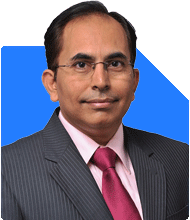Omkeshwar Singh | Answer |Ask -Follow
Head, Rank MF - Answered on Jan 14, 2022

I am a newbie and read your articles regarding mf investments and also great fan of yours.
I would like to make 1Cr. in next 15 years.
I am 43 years old started making SIP in following funds.
Kindly correct me in case of switch to required better funds.
| Mutual Funds | Amount |
| 1. BNP Paribas India consumption growth fund eqity | 2500 |
| 2. Hdfc banking and financial service growth fund equity | 2000 |
| 3. ICICI Prudencial flexi cap fund growth | 1000 |
The funds that may be considered are:
| Mutual Funds | Plan |
| Dsp Focus Fund | Growth |
| Axis Esg Equity Fund | Growth |
| Motilal Oswal S&p 500 Index Fund | Growth |
| Uti Flexi Cap Fund | Growth |
You may like to see similar questions and answers below
Omkeshwar Singh | Answer |Ask -Follow
Head, Rank MF - Answered on Dec 07, 2022
Ramalingam Kalirajan |10893 Answers |Ask -Follow
Mutual Funds, Financial Planning Expert - Answered on Apr 09, 2024
Ramalingam Kalirajan |10893 Answers |Ask -Follow
Mutual Funds, Financial Planning Expert - Answered on Apr 12, 2024
Janak Patel |71 Answers |Ask -Follow
MF, PF Expert - Answered on Jan 16, 2025
Reetika Sharma |425 Answers |Ask -Follow
Financial Planner, MF and Insurance Expert - Answered on Oct 11, 2025
Ramalingam Kalirajan |10893 Answers |Ask -Follow
Mutual Funds, Financial Planning Expert - Answered on Dec 15, 2025
Ramalingam Kalirajan |10893 Answers |Ask -Follow
Mutual Funds, Financial Planning Expert - Answered on Dec 15, 2025
Radheshyam Zanwar |6746 Answers |Ask -Follow
MHT-CET, IIT-JEE, NEET-UG Expert - Answered on Dec 15, 2025
Ramalingam Kalirajan |10893 Answers |Ask -Follow
Mutual Funds, Financial Planning Expert - Answered on Dec 15, 2025
Ramalingam Kalirajan |10893 Answers |Ask -Follow
Mutual Funds, Financial Planning Expert - Answered on Dec 15, 2025
Ramalingam Kalirajan |10893 Answers |Ask -Follow
Mutual Funds, Financial Planning Expert - Answered on Dec 15, 2025
Samraat Jadhav |2508 Answers |Ask -Follow
Stock Market Expert - Answered on Dec 15, 2025
Ramalingam Kalirajan |10893 Answers |Ask -Follow
Mutual Funds, Financial Planning Expert - Answered on Dec 15, 2025
Reetika Sharma |425 Answers |Ask -Follow
Financial Planner, MF and Insurance Expert - Answered on Dec 15, 2025
Radheshyam Zanwar |6746 Answers |Ask -Follow
MHT-CET, IIT-JEE, NEET-UG Expert - Answered on Dec 15, 2025




























